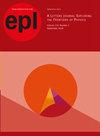Firehose instability in heat-conducting solar wind plasmas including FLR corrections and electrical resistivity
IF 1.8
4区 物理与天体物理
Q2 PHYSICS, MULTIDISCIPLINARY
引用次数: 0
Abstract
The effects of finite Larmor radius (FLR) corrections and heat-flux vector are studied on the pressure anisotropy-driven firehose instability in finitely conducting solar wind plasmas described by the double-adiabatic Chew, Goldberger and Low (CGL) fluid theory. The fluid description of collisionless plasmas is governed through modified adiabatic equations due to the heat-flux vector and finite ion Larmor radius corrections. The analytical dispersion relation of the firehose instability has been derived using the normal mode analysis and discussed in the solar wind plasmas. In the transverse mode, the dispersion relation of the Alfvénic mode is modified due to electrical resistivity and FLR corrections. In the longitudinal mode, the effects of the heat-flux parameter and electrical resistivity are observed separately. The dispersion relation of the firehose mode is modified due to the combined effects of FLR corrections and electrical resistivity. The graphical illustrations show that finite electrical resistivity and ion Larmor frequency destabilize the growth rate of the firehose instability. The results are useful for analyzing the solar mission data to study the firehose instability in the solar wind plasmas.导热太阳风等离子体中的火管不稳定性,包括 FLR 校正和电阻率
研究了有限拉莫尔半径(FLR)修正和热流矢量对有限传导太阳风等离子体中压力各向异性驱动的喷火管不稳定性的影响,该等离子体由双绝热Chew、Goldberger和Low(CGL)流体理论描述。由于热流矢量和有限离子拉莫尔半径的修正,对无碰撞等离子体的流体描述是通过修正绝热方程进行的。利用正常模式分析推导出了火管不稳定性的分析弥散关系,并在太阳风等离子体中进行了讨论。在横向模式中,由于电阻率和有限离子拉莫尔半径修正,阿尔费尼克斯模式的频散关系发生了变化。在纵向模式中,分别观察了热流参数和电阻率的影响。由于 FLR 修正和电阻率的综合影响,火管模式的频散关系发生了变化。图示表明,有限的电阻率和离子拉莫尔频率破坏了火管不稳定性的增长率。这些结果有助于分析太阳任务数据,研究太阳风等离子体中的火管不稳定性。
本文章由计算机程序翻译,如有差异,请以英文原文为准。
求助全文
约1分钟内获得全文
求助全文
来源期刊

EPL
物理-物理:综合
CiteScore
3.30
自引率
5.60%
发文量
332
审稿时长
1.9 months
期刊介绍:
General physics – physics of elementary particles and fields – nuclear physics – atomic, molecular and optical physics – classical areas of phenomenology – physics of gases, plasmas and electrical discharges – condensed matter – cross-disciplinary physics and related areas of science and technology.
Letters submitted to EPL should contain new results, ideas, concepts, experimental methods, theoretical treatments, including those with application potential and be of broad interest and importance to one or several sections of the physics community. The presentation should satisfy the specialist, yet remain understandable to the researchers in other fields through a suitable, clearly written introduction and conclusion (if appropriate).
EPL also publishes Comments on Letters previously published in the Journal.
 求助内容:
求助内容: 应助结果提醒方式:
应助结果提醒方式:


